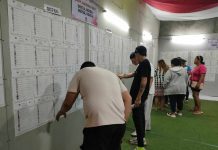[av_one_full first min_height=” vertical_alignment=” space=” custom_margin=” margin=’0px’ padding=’0px’ border=” border_color=” radius=’0px’ background_color=” src=” background_position=’top left’ background_repeat=’no-repeat’ animation=”]
[av_heading heading=’URBAN FARMER ‘ tag=’h3′ style=’blockquote modern-quote’ size=” subheading_active=’subheading_below’ subheading_size=’15’ padding=’10’ color=” custom_font=”]
BY JULIO P. YAP JR.
[/av_heading]
[av_textblock size=” font_color=” color=”]
Importance of brown rice
BROWN rice, which is also known as pinawa, is a whole grain cereal produced by removing only the hull using mortar-and-pestle or rubber roller milling machine.
The bran layer (darak) is retained giving the grain its brown color and keeping its high levels of soluble fiber antioxidants and other vitamins and minerals.
In promoting the importance of brown rice, the Philippine Rice Research Institute (PhilRice) recently kicked off the celebration of the National Rice Awareness Month (NRAM) during the celebration of the Institute’s 31st Anniversary.
This year’s NRAM focuses on mainstreaming brown rice as an alternative food staple to white rice.
The country faces problems such as undernourishment, low income of rice farmers, rice insufficiency, and hunger. To help address these issues, promotion of brown rice consumption is necessary.
The main activity of NRAM is the #BROWN4good Challenge, a social media campaign that seeks to promote brown rice as a “good” food, led by the Be Riceponsible Campaign.
The first goodness is for the body noting its health benefits.
Second is goodness for the farmers especially those who belong to farmer cooperatives that are linked to hotels, restaurants, supermarkets, and other market outlets for brown rice.
Third, goodness is for the country.
A PhilRice study revealed that brown rice has a 10 percent higher milling recovery advantage that would result in about 1.2 million MT additional edible rice supply.
Lastly, the fourth goodness is for the less fortunate.
Every hashtag is equivalent to one cup of brown rice which will be donated to partner-charities nationwide.
PhilRice is eyeing at least 50,000 hashtags per region and has partnered with the LGUs and DA-RFO as well as other groups for this.
Also part of the NRAM celebration is the opening of the exhibit titled Evolution of Novo Ecijano’s Farming System and Filipino Costumes.
The exhibit, which will run until November 30 at the Central Luzon Agricultural Museum in Central Luzon State University (CLSU), highlights farm implements representing the emergence of Nueva Ecija as rice granary and the Ayala doll collection.
The featured farm implements, which were researched and curated by the Rice Science Museum, are part of its cultural mapping study being conducted in the country’s top rice producing provinces.
On the other hand, the 42-year-old doll collection dramatizes the distinctive features of the Filipino clothes with some from farming communities.
Made out of wood, the dolls have similar clothing materials and body adornments worn by the people they represent.
In engaging the youth in nation-building, platforms must be used as Filipinos also better retain information through visual and interactive experiences.
NRAM is celebrated every November pursuant to Presidential Proclamation No. 524, Series of 2004./PN
[/av_textblock]
[/av_one_full]







